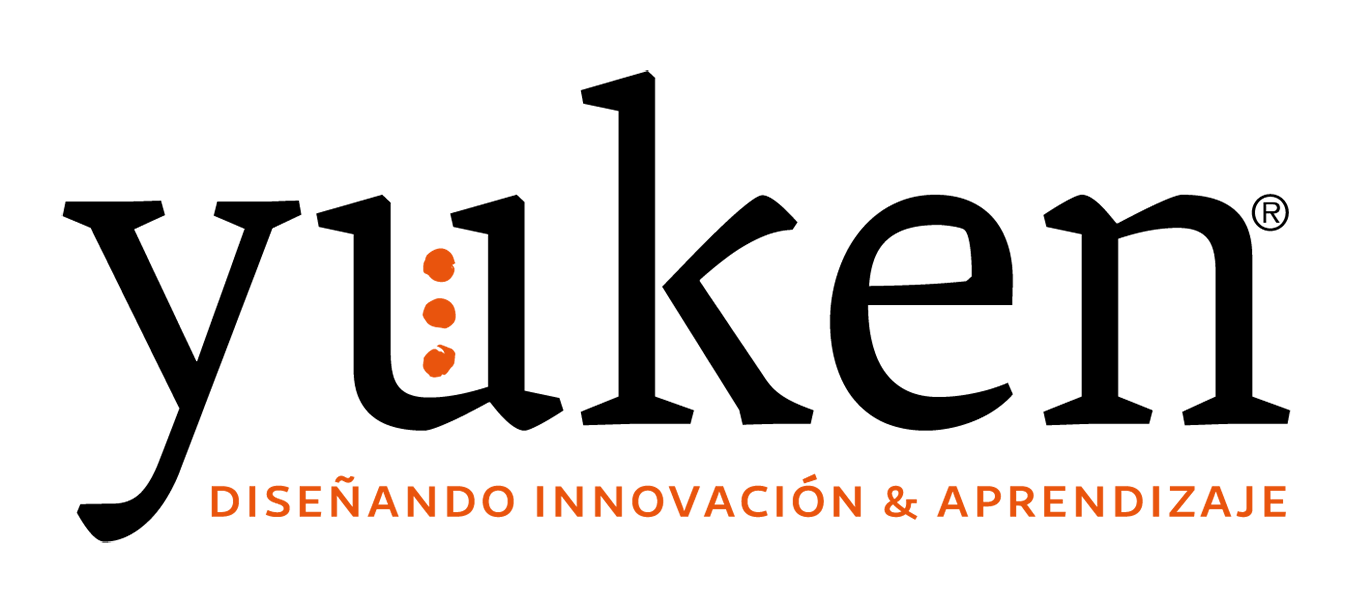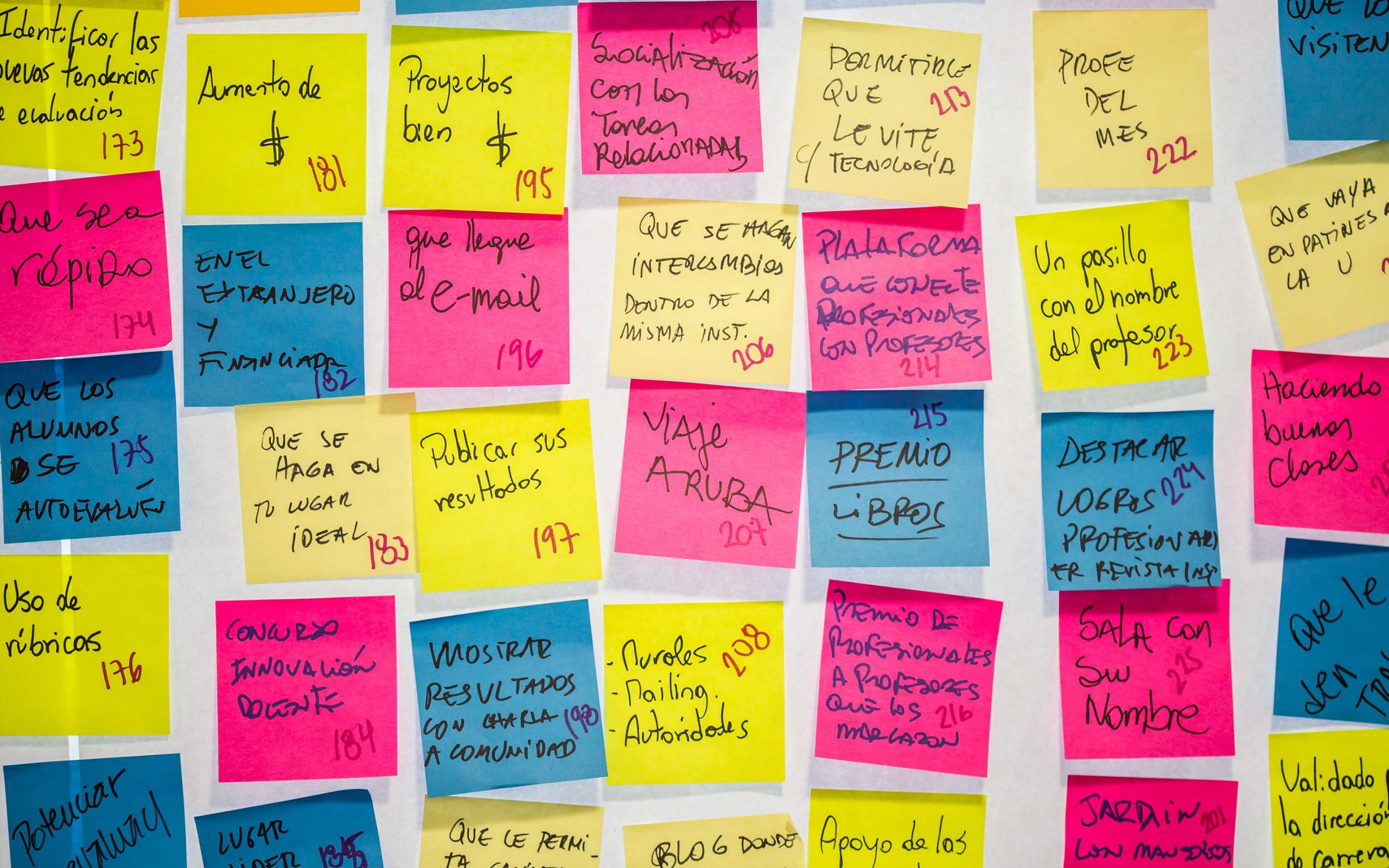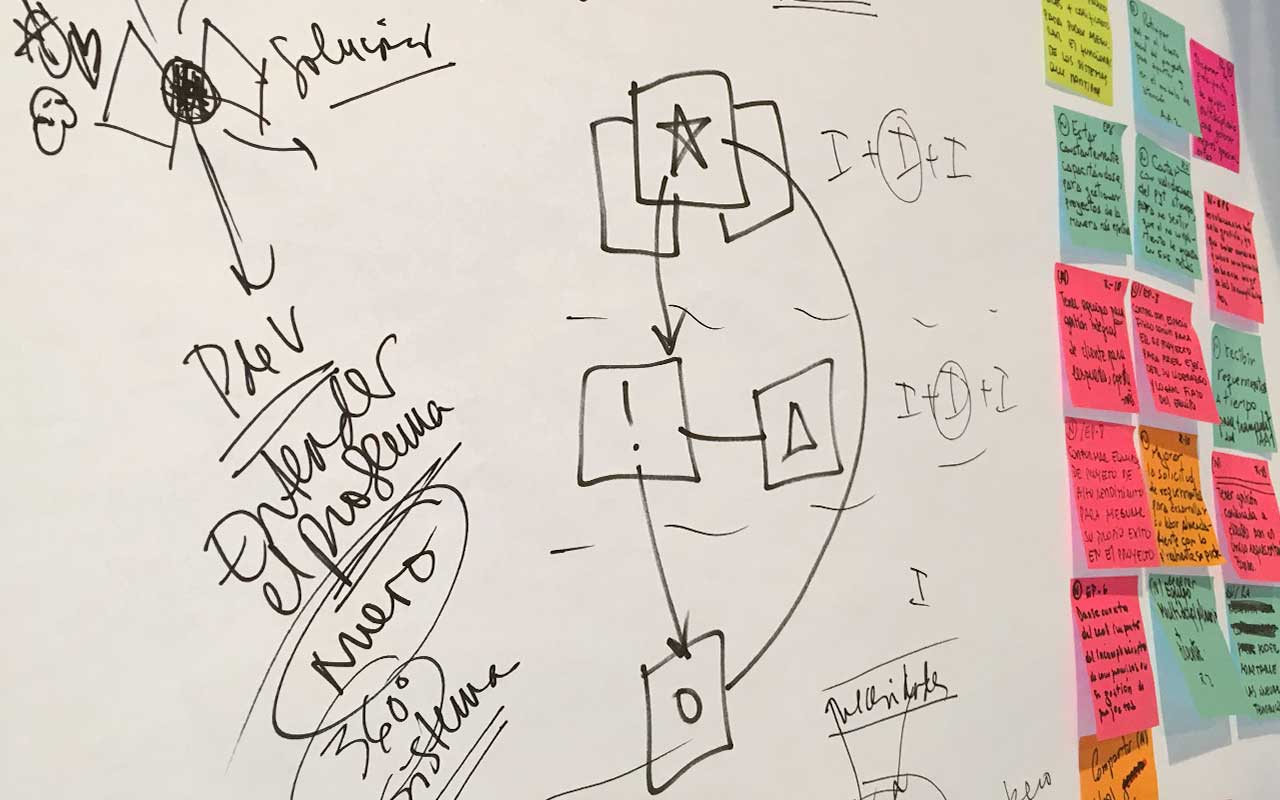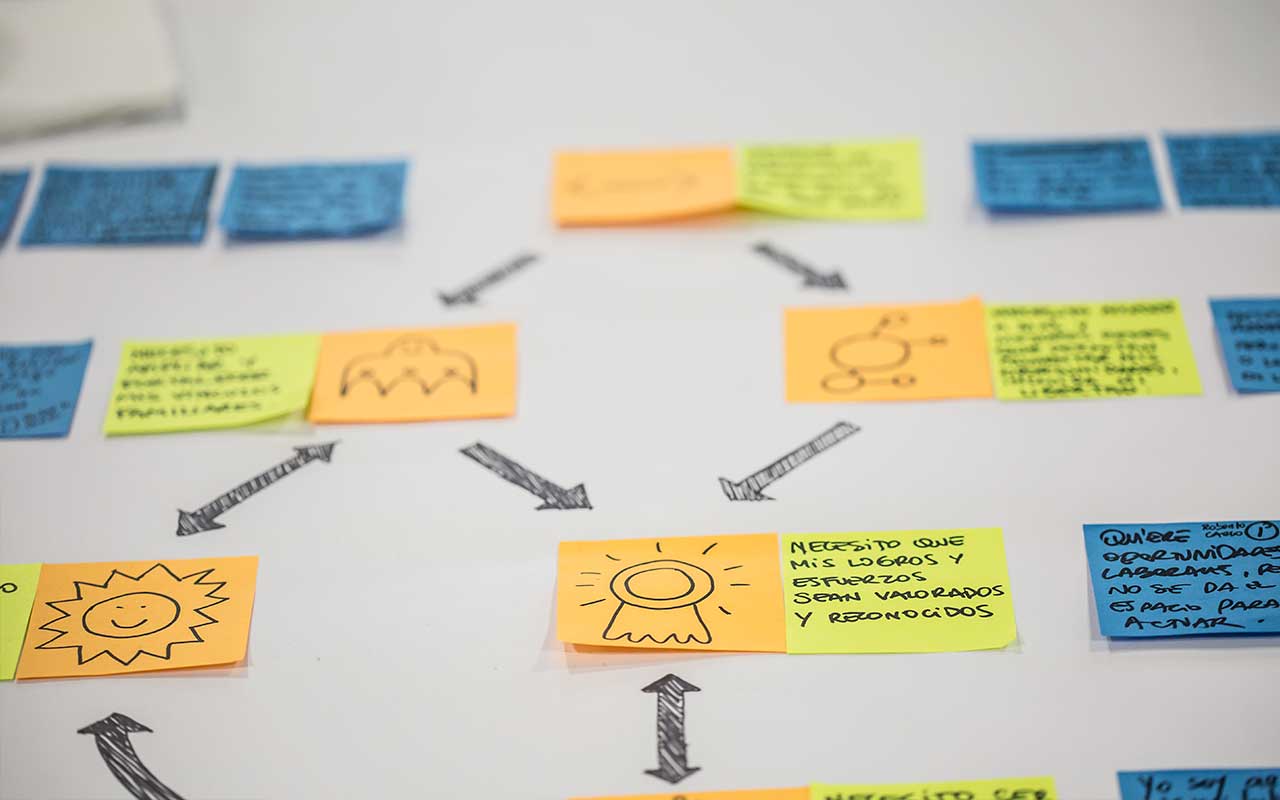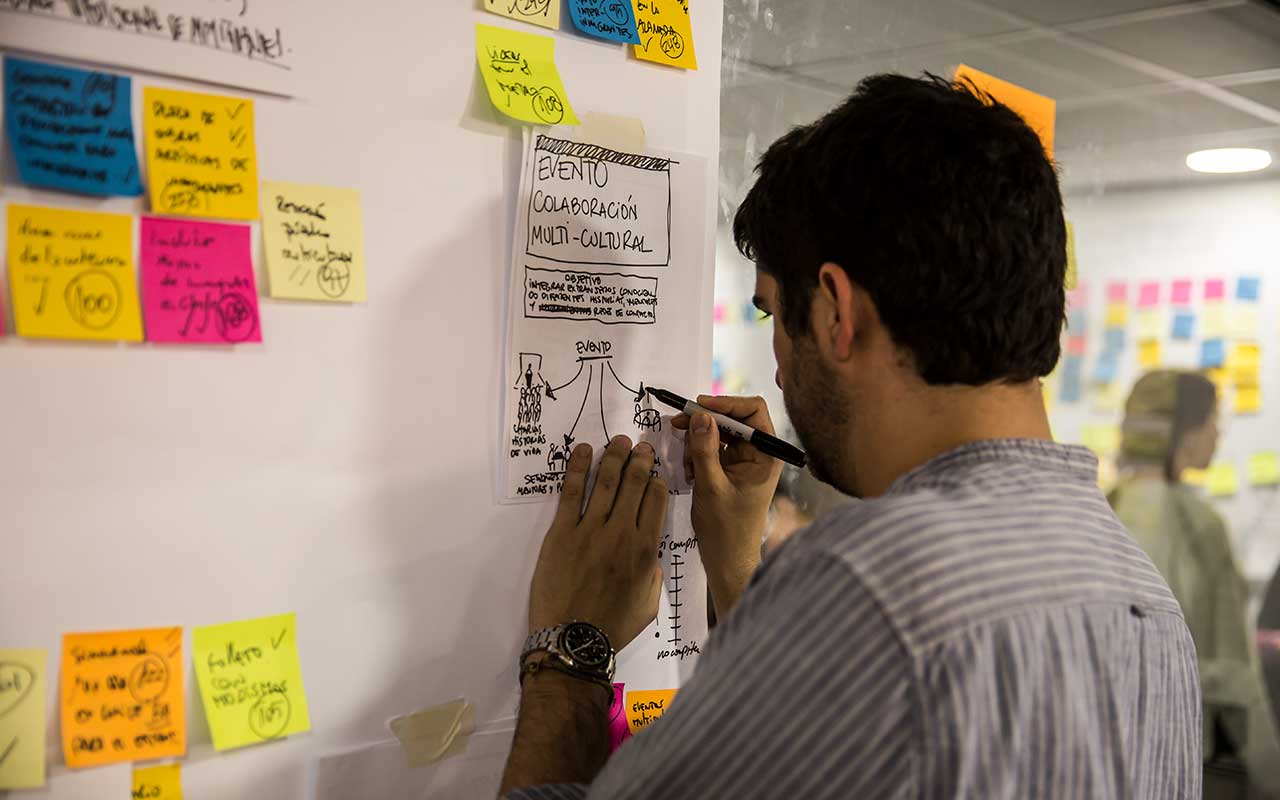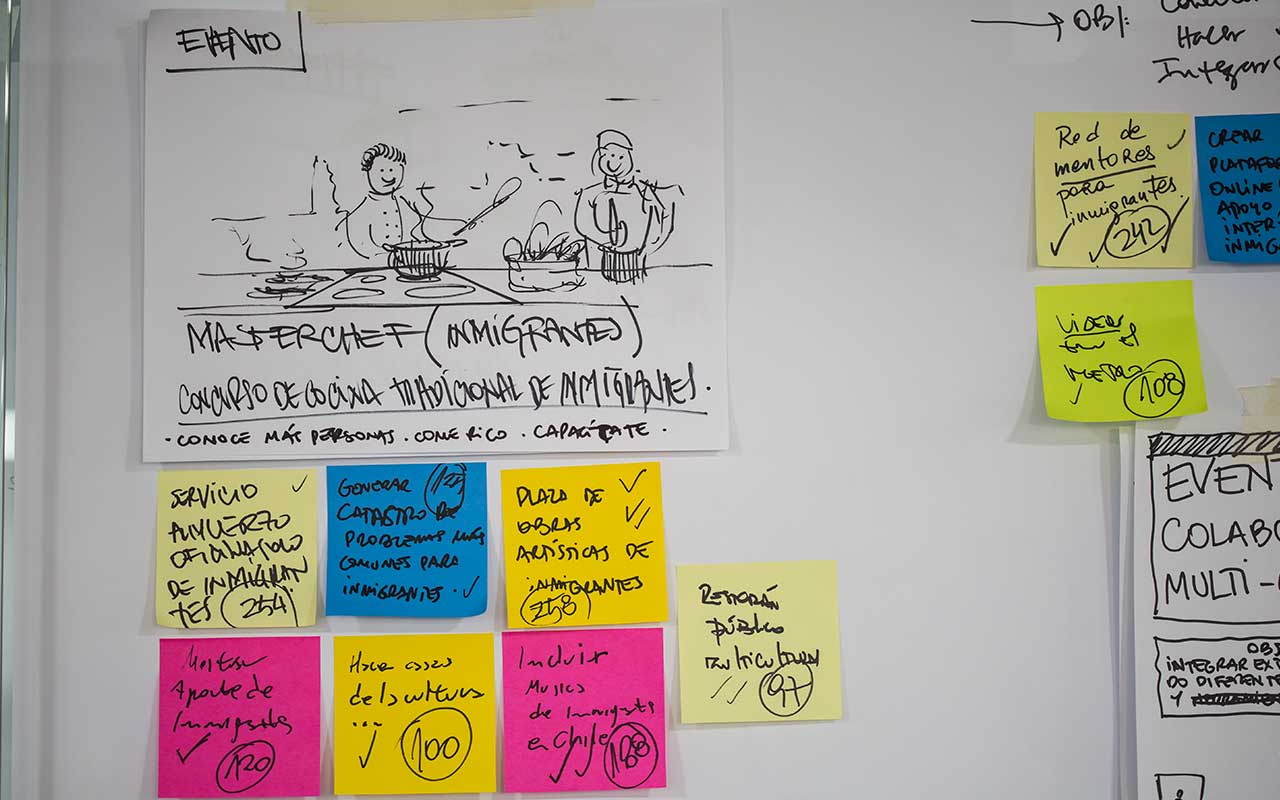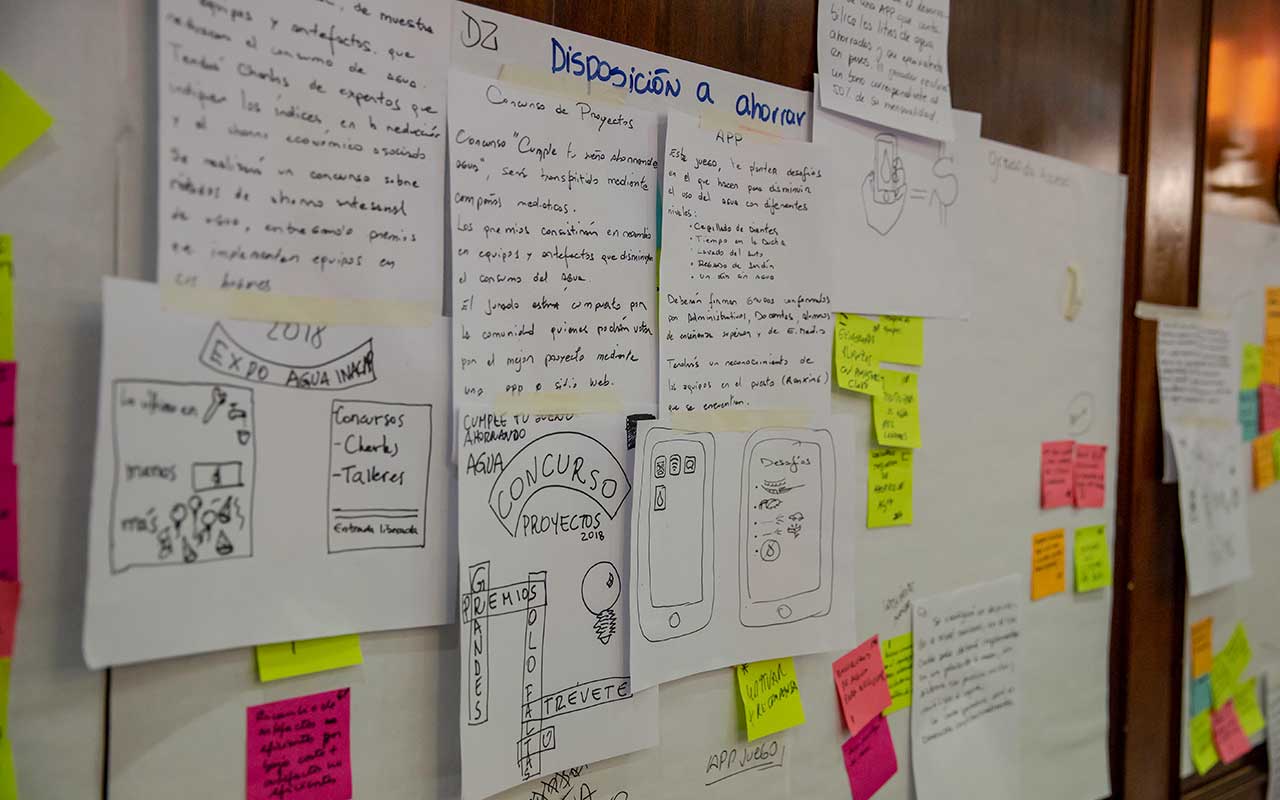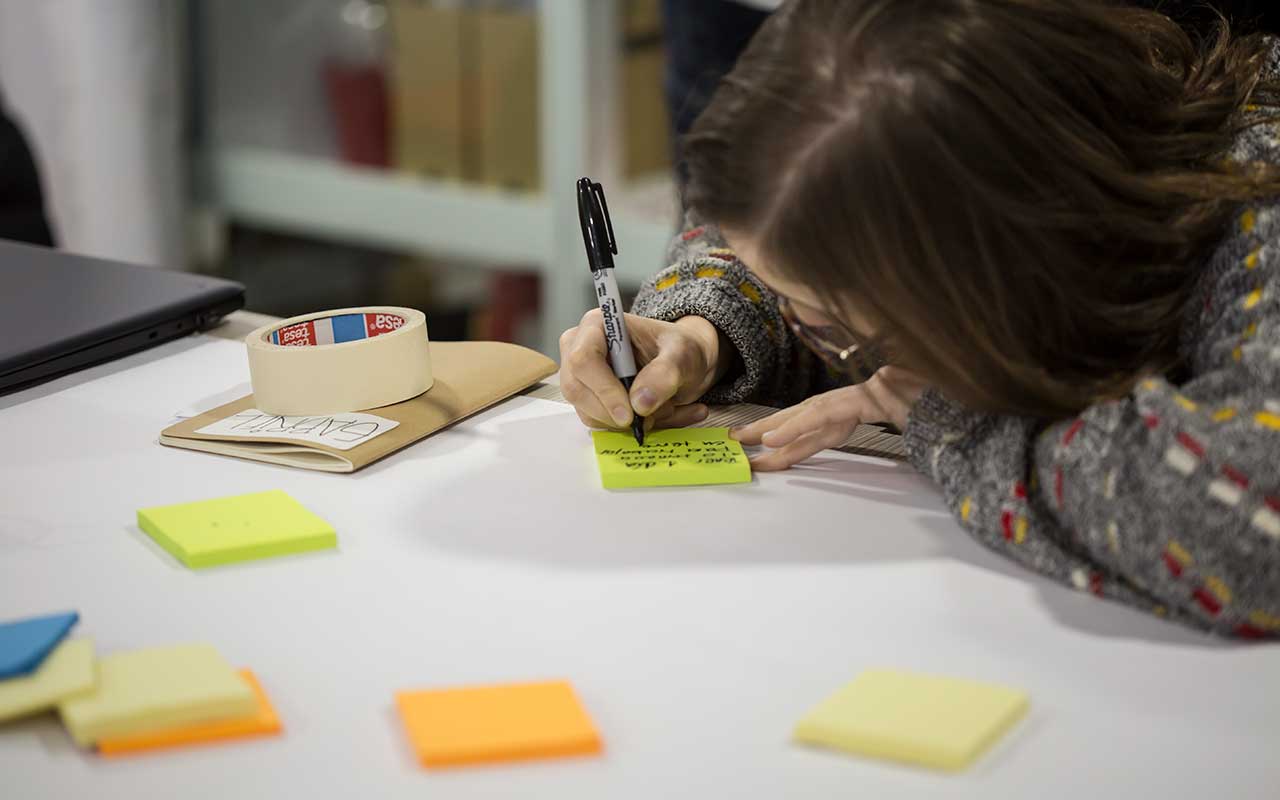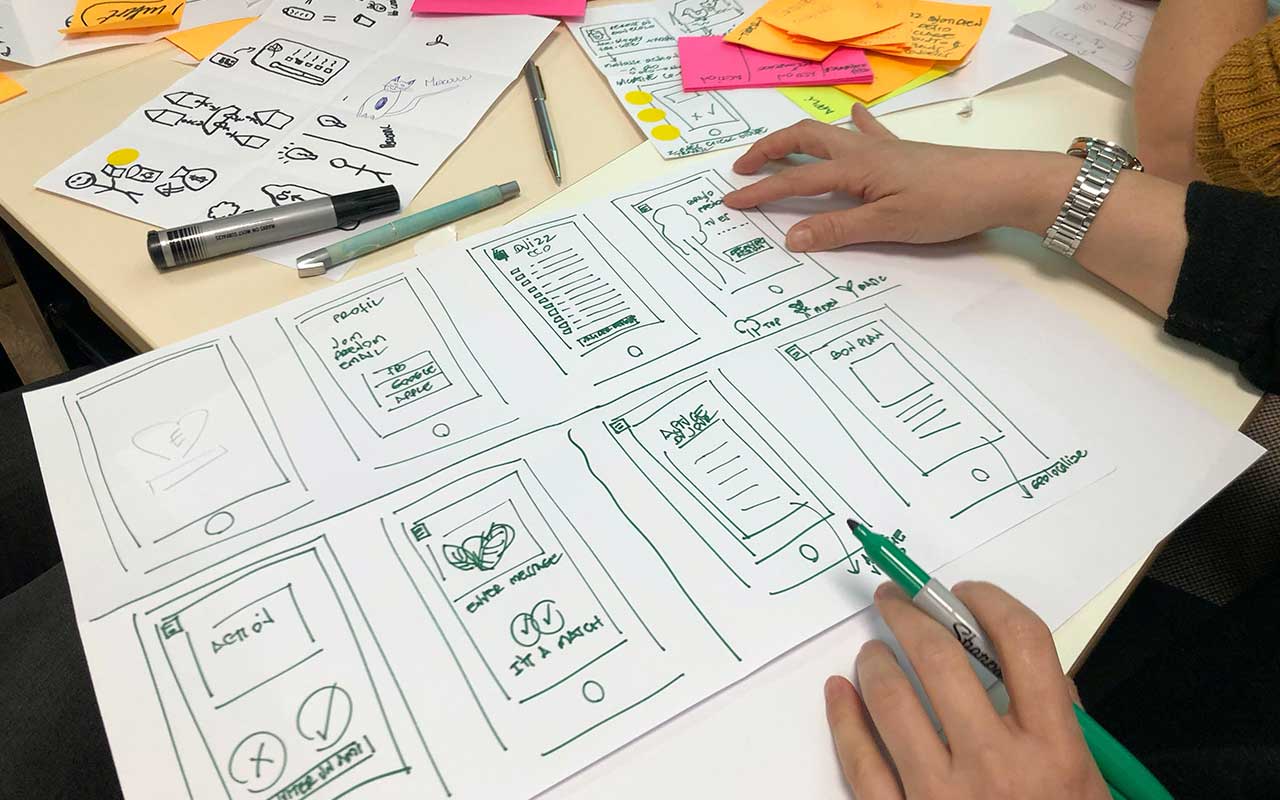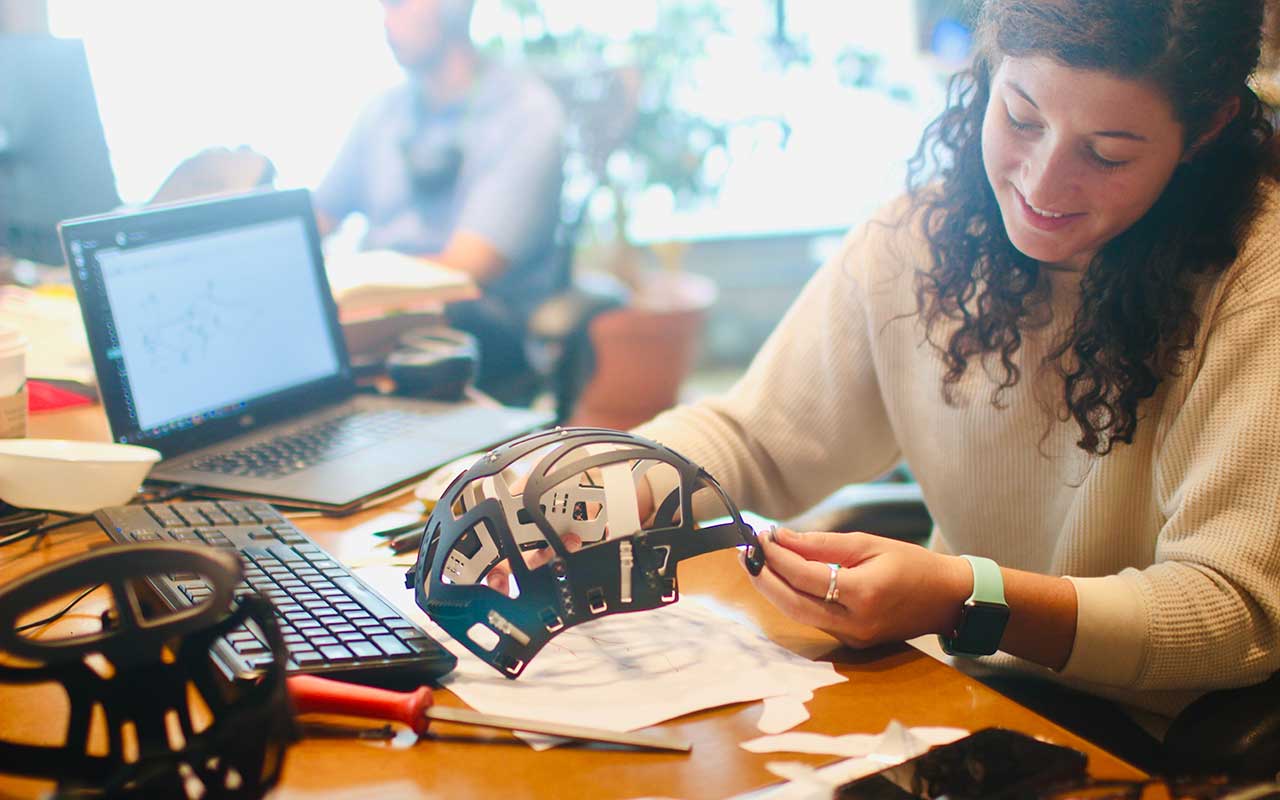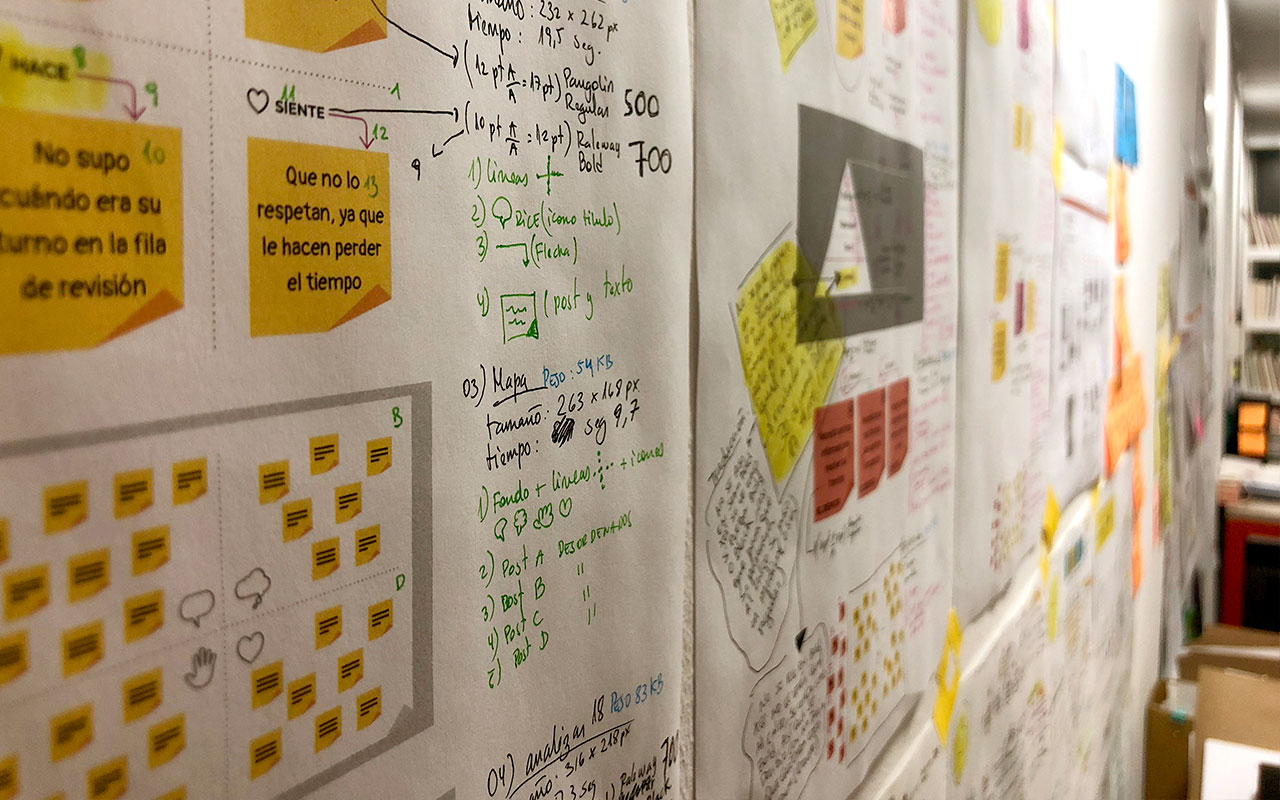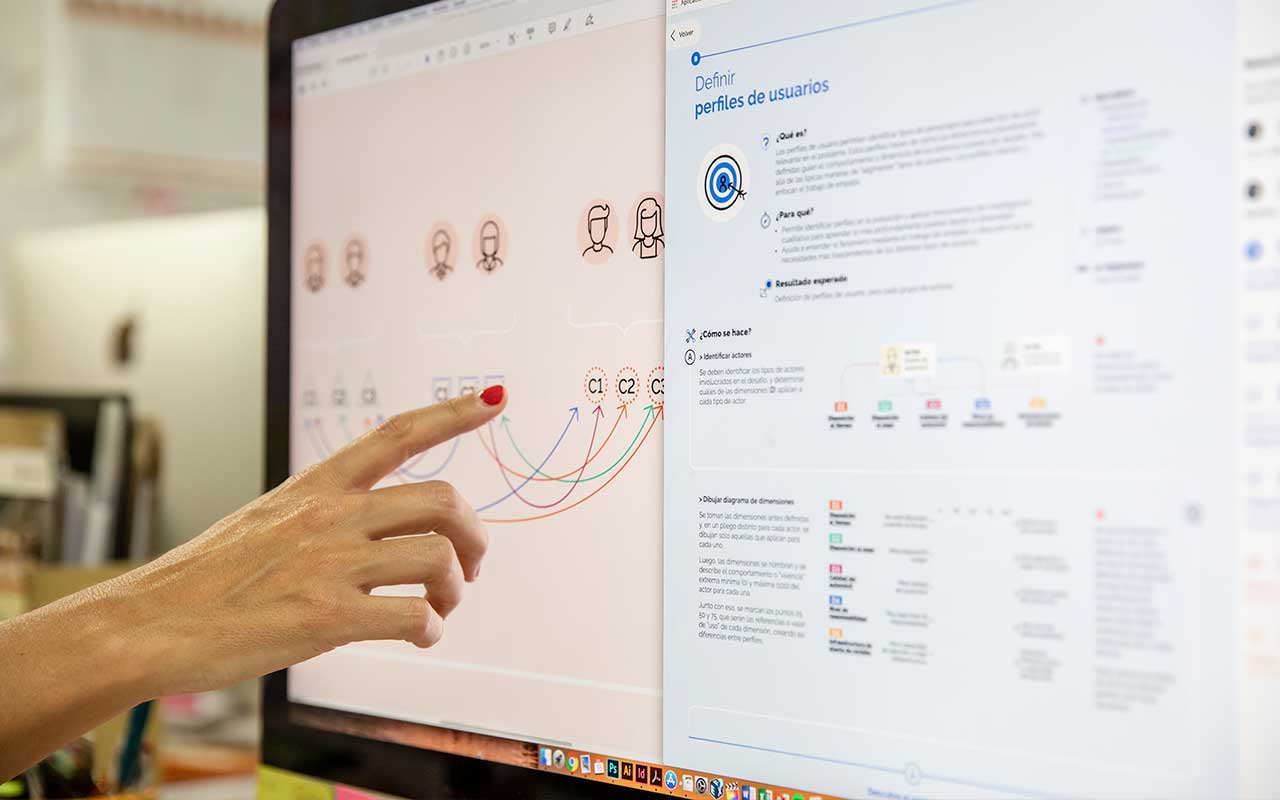METHODOLOGICAL FRAMEWORK
Project process in design as a guideline and systemic methodology for innovation
At Yuken we focus on solving complex problems through processes that are effectively focused on the user –considering the satisfaction of the needs of the system of actors involved– whose implementation generates a positive local and global impact.
In our design laboratory, this translates into the development and implementation of projects aimed at achieving the challenges and objectives of our clients. For this, the work of our team is essential, made up of designers and developers who are experts in User Research, UX, UI and Design Sprints for the development of interactive, didactic, information design and editorial platforms.
For each project, whether commissioned or self-managed, we follow a methodological framework that systematizes the Design Process in design. Several authors (among which we highlight Simon, 1969; Zimmerman, Forlizzi, and Evenson, 2004; Kolko, 2007, 2009, 2010; Aspelund, 2014) configure a procedure of “investigation, synthesis, creation, and reflection” (Zimmerman, Forlizzi, and Evenson, 2004) that is related to solving complex problems by satisfying the needs of the actors involved, generating systemic solutions to implement with a positive impact in their context.
Below we present our procedural synthesis, highlighting the phases and their main objectives.
1. Conduct immersive, ethnographic and qualitative research
Main objective: Empathic inquiry
This first stage of the process seeks to understand the problem or challenge and empathize with its systemic context (territory, actors and users). That is, define and frame the problem, deeply understand the needs of the system and, being qualitative —not quantitative—, focus on and even celebrate the extremes of the profiles of those users who experience it. The aim is to understand and generate a relationship with the singularities in the life of the participating actors, and thus observe their own solutions or strategies —many times extremely local, unique and tacit— to face the complexity of their environment of action. Qualitative inquiry focuses on observing and empathically connecting(1) with a small group of people, selected precisely for their unique traits —thus defining theoretically valid subject profiles—, who navigate the different dimensions that constitute the problem.
1. In our work team we give meaning to the meaning of empathy as the imaginative capacity to temporarily exchange, or at least complement, one’s own perspective with that of another recognized as valid. This means, precisely, that the person in whom we are empathically inquiring is much more than a research subject or record; That person is our source of learning and discovery, of surprise and connection with a context that we must declare as not our own (in order to manage our own anchors and biases). It is empathizing, and not a simple “sympathizing”.
Sampling methods for qualitative research follow a different rationale than in quantitative research, where sample validity is given by the theoretical quality of the subjects (instead of the size of a sample that is unbiased and representative of a larger universe).
Qualitative inquiry focuses on empathically observing and connecting with a small group of people, selected precisely for their unique traits”
For the selection of subjects, purposive sampling —or deliberate sampling— is usually chosen as the method given the success it has had with mixed research methods (Palinka et al. 2015), effectiveness in identifying subjects rich in information (Patton, 2002) , and its effectiveness for content analysis (Prior, 2014).
In this type of sampling, the research team defines archetypes —or profiles— for different types of actors based on obtaining the maximum possible variation with respect to the variables or dimensions that are thought to explain the phenomena that give rise to the problem to be solved. Then, through an ethnographic study and complement with other qualitative methods, the hypotheses are validated through content analysis. See Altheide (1987) for more details on this.
The relevance of the subjects to be investigated is emphasized, due to the fact that every design project process focuses on the user as a source of learning both the problem and the solution.
2. Make sense and define the design and innovation opportunity
Main objective: Design synthesis
While synthesis is used throughout the design process, it is most often done at this definition stage. At this point in the project, large amounts of information and data will have been collected from people and thus from the problem and its various dimensions to be understood. These data, arranged in multiple formats —text, quotes, photographs and images, diagrams, among others— need to be analyzed, organized, understood (Kolko, 2007) and, furthermore, integrated to make sense of the challenge. Isolated data is useless to define a solution from design; they do not present the strategic potential of design thinking, since the data is inactive and lacks context (Shedroff, 2000). The design team is responsible for doing something with the data, “using” it, extracting the meaning or generating the meaning associated with it. It is at this time that connections begin to form that would otherwise be hidden; behavioral anomalies are identified that may even fit outside of the team’s worldview; constantly asks and answers the question “Why?” (Kolko, 2007). The development of abductive thinking here is key, since the team relies on hypotheses as a form of inference (Peirce, 1998).
This is custom heading element
In this way, design synthesis is always generative: it always produces more data, information and knowledge and is different from (i) an empirical study that seeks to understand things that already exist (although it remains objective), and (ii) a predictive behavioral study that seeks to identify causality and what people are likely to do (by remaining targeted). Synthesis (and design as a whole) seeks to understand the dimensions and distinctions of things that do not yet exist by bringing them into being; it helps to infer what people will do, feel or think when there is what does not yet exist (Simon, 1969; Kolko, 2009).
The result of this stage is, precisely, the design synthesis where the latent needs of the various user profiles are articulated with the opportunity discoveries (insights) and the understanding of the design opportunity that exists is developed. The design team visually explores this articulation of connections in an effort to make and communicate meaning (Dervin, 2003). These visualizations can be used to communicate with other members of the design team (giving meaning), or they can be used as platforms for concept sketching or prototyping (next task). This stage generates a structured framework for design solutions; Frequently, the action of outlining is used as a form of synthesis to produce knowledge and meaning in an active and didactic way, promoting its understanding and integration by the team.
This is custom heading element
3. Design the proposed solution
Main objective: Generate new design spaces
Once the design problem has been identified and defined, methods must be considered toconceptualize different design spaces and thus create a value solution. Ideas emerge—probably from brainstorming—as natural extensions of a better understanding of the problem space and, in this context, a design concept is an abstract vision of how the fusion and connection of multiple ideas needs to become something tangible. This is where the synthesis process intervenes again; this time with a generation focus.
The final proposal must resolve the defined problem, contribute to the creative resolution of the design opportunity found, and be defined based on aesthetic, cultural, formal, functional, productive, and market attributes; everything, with the focus on solving the needs and promoting the systemic opportunities of the user and the actors involved. In this way, to give shape to the artificial (Simon, 1969), analogies, metaphors and intuitive thinking are tools that are very useful for visualizing, describing and explaining non-existent objects (new products, services, experiences or systems).
The final proposal must resolve the defined problem, contribute to the creative resolution of the design opportunity found, and be defined based on aesthetic, cultural, formal, functional, productive, and market attributes”
New perspectives describe design constraints, implicit in the opportunity space context and thus act as artificial requirements: they provide a container to help describe “good” and “bad” design ideas. In this sense, initially perceptions act as selection criteria for ideation. When exploring and experimenting activities progress, the cognitive selection criteria generated by perceptions are complemented by the more objective experiential search (Gavetti & Levinthal, 2000).
4. Experiment: development of prototypes and testing with users
Main objective: Hypothesis validation
Experimentation is a means of determining the validity of hypotheses and assumptions, exploring solution options, and learning by failure about what might not work. It is the main selective search mechanism (March and Simon 1958; March 1991) and therefore central to the design process. The experimentation considers three fundamental activities:
Planning of the experiments to be carried out. It defines the hypotheses and assumptions that will be tested, the actors involved in each one, type and quality of the prototypes to be developed, test conditions and level of fidelity (level of resolution and functionality), and how the results will be analyzed.
Development of real artifacts (prototypes). Consider creating artifacts (tangible representations of the solution). The artifact creation process forces the selection of ideas, their combination and visualization of different concepts in alternative design spaces that represent different hypotheses; a “decomposition of design into related, functional components” (Simon, 1969). Each prototype is a means used by the design team to communicate ideas and concepts to the different stakeholders involved in a challenge, which should allow them to understand the attributes of the solution and, by identifying its limitations, explore how to improve it.
Test the results with real people. The tests force you to take the artifacts and make the actors involved use them to achieve their objectives. Depending on the fidelity level of the prototype, the tests can respond to conditions that vary greatly from real use situations.
Each prototype is a means used by the design team to communicate ideas and concepts to the various stakeholders relevant to a challenge, which should allow them to understand the attributes of the solution and, by identifying its limitations, explore how to improve it.”
Considering the costs and time involved in developing cycles of planning, developing and testing prototypes, experimentation should be gradual and sequential in terms of refinement and functionality. In this way, the degree of advancement in functionality and refinement responds to maximizing learning and validation of hypotheses at the shortest possible time and cost (Osorio 2010). Thus, experimentation can feed the evaluation and selection of alternatives in a sequential and gradual manner, effectively maximizing learning.
As a result, experimentation evolves through preliminary prototypes of low resolution and functionality with low fidelity and cost tests, increasing as alternatives are evaluated until the selection of a solution concept that responds to the problem of each one of the dimensions of a challenge, from a systemic perspective. Then, a validation prototype is generated and they perform high fidelity tests (of the highest functionality, resolution and systemic integration).
The validation prototype represents a refined version of the solution, fully functional and on a real scale, which has been reached after (i) testing most of the hypotheses and assumptions of the project, (ii) carrying out experiments that allow solving the most of the problems and doubts, and (iii) explore its degrees of flexibility in its use, and (iv) see the feasibility of integrating it into the system.
Once the validation prototype is finished, the Innovation Brief(2)is generated. This document presents the technical specifications of how innovation should be implemented on a large scale: How are its parts integrated? How is it manufactured/produced? Who are the suppliers? What critical aspects should be considered in its distribution chain?, and questions that are still open so that the team in charge of system-level design can finish its development.
2. For our work team, the expected result of the Brief is: A detailed document with the technical specifications of the innovation as a system, including renders, definition of its components and software source code, if required. It must include: a) Refined business model report, b) Detailed report of the tests that must still be carried out on the innovation, c) Detailed report of the tests that should be carried out for the design of its production system, commissioning March, and operation, and d) Preliminary management plan for the first year of exploitation of the solution.
5. Commissioning
Main objective: Launch, refinement and diffusion
Once the validation prototype is finished, the solution is released as a preliminary version to meet the objectives of (i) identifying inadvertent errors during integration, (ii) testing hypotheses and assumptions that require a fully functional and high-resolution prototype, and (iii) learn about the impact in your context.
The three objectives are achieved by designing experiments aimed at testing the solution under real conditions of use, that is, with full fidelity. For this, the solution must be stressed trying to make it fail and find possible problems that may arise in extreme situations (for example, facing many users requesting the same resource at the same time).
Throughout this process, it is extremely important to collect data before and after the launch to measure the impact of the solution. In this sense, the gathering of information will provide the necessary feedback to measure the performance of the implemented solution, and thus find and solve usability problems and be able to refine it.
Finally, implementation is a fundamental requirement to meet the objective of disseminating the solution and thus promoting its scaling and positioning.
